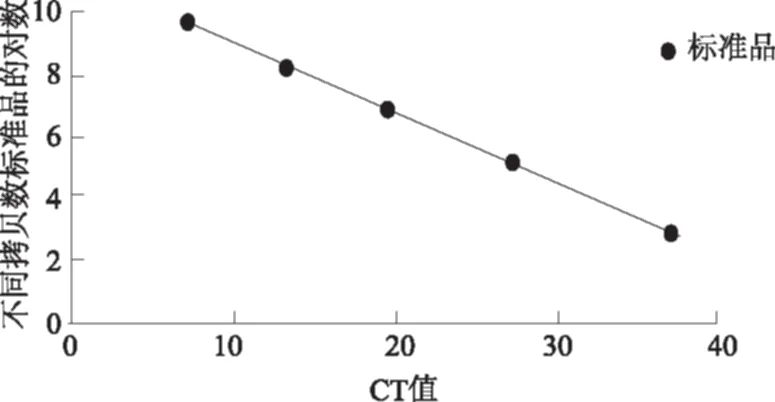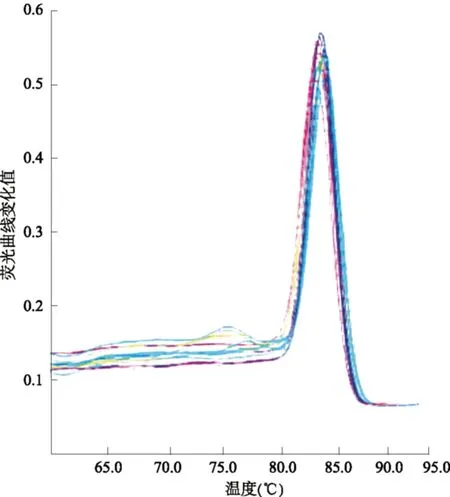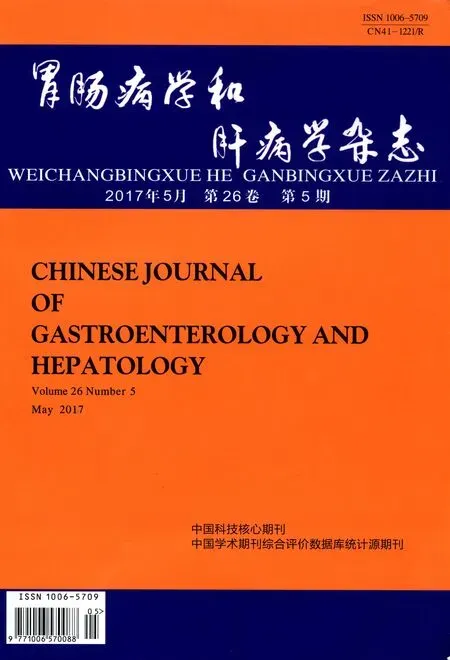肠易激综合征患者肠道中难辨梭状芽胞杆菌的变化
郑 洁,贾彦彬,2,党 彤
1.包头医学院第二附属医院内蒙古消化病研究所,内蒙古 包头 014030; 2.包头医学院基础医学与法医学院病原生物学教研室
肠易激综合征患者肠道中难辨梭状芽胞杆菌的变化
郑 洁1,贾彦彬1,2,党 彤1
1.包头医学院第二附属医院内蒙古消化病研究所,内蒙古 包头 014030; 2.包头医学院基础医学与法医学院病原生物学教研室
目的 观察肠易激综合征(irritable bowel syndrome, IBS)患者肠道中难辨梭状芽胞杆菌(Clostridium difficile,C.difficile)含量的变化,探讨IBS与C.difficile的相关性。方法 根据罗马Ⅲ标准,收集包头医学院第二附属医院消化科收治的IBS患者30例,同时选取30名健康体检者作为对照组,利用实时荧光定量PCR方法检测研究对象粪便中C.difficile含量。结果 与对照组比较, IBS患者及各亚型患者肠道C.difficile含量差异无统计学意义(P>0.05)。结论 IBS可能与C.difficile无相关性。
肠易激综合征;难辨梭状芽胞杆菌;实时荧光定量PCR
近年来,由于患病率逐渐增加,肠易激综合征(irritable bowel syndrome, IBS)受到广泛关注。根据粪便的性状不同,IBS分为腹泻型(IBS-D)、便秘型(IBS-C)、混合型(IBS-M)、不定型(IBS-U)[1]。目前,IBS发病机制尚不明确,有研究表明,IBS与肠道菌群有着密切关系[2]。
难辨梭状芽胞杆菌(C.difficile)是厌氧革兰阳性杆菌,可引起C.difficile相关性腹泻[3],一般是由服用抗生素或感染引起。本研究利用实时荧光定量PCR方法,观察IBS患者肠道C.difficile的变化,为临床指导抗生素对IBS的治疗有一定的意义。
1 资料与方法
1.1 一般资料 收集2015年1月-2015年7月在包头医学院第二附属医院消化科就诊的IBS患者共30例,另选取健康体检者30名作为对照组。
1.2 纳入标准 根据罗马Ⅲ诊断标准[4],IBS组:反复出现腹痛或腹部不适,诊断时,症状已出现≥6个月,最近3个月内每个月典型症状发作≥3 d,同时伴有以下2种或2种以上症状:(1)排便后症状缓解;(2)发作时排便频率发生变化;(3)发作时排便的形状改变,此外,腹部不适是指无法用疼痛来形容的不适感。支持诊断:(1)异常频率变化:每周排便次数<3次或每天排便次数>3次;(2)粪便性状的变化:块状便/硬便或松散便/稀水便;(3)排便费力,下坠感,排便急迫感或排便不尽感,排出黏液及腹胀。排除标准:(1)患者行相关辅助检查,如血、尿、便常规、生化常规、腹部超声及电子结肠镜等,有肠道器质性病变;(2)年龄<18岁;(3)有心血管、呼吸、肾脏等其他系统的严重疾病者;(4)有腹部手术史者;(5)怀孕期或哺乳期者;(6)患者近2周内使用过膨胀剂、止泻药、抗菌药物、解痉药、益生菌制剂药物。
健康对照组的选取:来自健康体检者,除外病例组选取标准及其排除因素,同时性别、年龄、民族、生活环境等基本情况均与病例组相匹配。
1.3 方法
1.3.1 粪便标本收集、DNA提取及总DNA纯度、浓度的检测:所有研究对象在自然排便后,迅速用无菌棉签取适量中段新鲜的粪便(至少2 g),放置无菌便盒内,2 h内将粪便标本于-80 ℃冰箱保存备用。利用TIANamp Stool DNA Kit(DP328)试剂盒(TIANGEN 公司)提取粪便DNA,并于-20 ℃冰箱保存。使用紫外分光光度计(Thermo scientific 公司)检测总DNA浓度及OD260/OD280比值。
1.3.2 引物的设计与合成:根据所查阅文献设计PCR引物[5-6],在NCBI数据库中使用BLAST软件比对引物的特异性,并送至上海生工试剂公司合成。C.difficile的引物为F:5′-TTGAGCGATTTACTTCGGTAAAGA-3′,R:5′-CCATCCTGTACTGGCTCAC CT-3′。
1.3.3 标准品制备:以提取对照组的粪便DNA为模板,进行PCR扩增,反应体系(50 μl)(杭州BIO SCI 公司):Taq PCR Master Mix (2×) 25 μl,Forword primer(10 μmol/L) 1 μl,Reverse primer (10 μmol/L)1 μl,DNA模板(2.5~50 ng) 2 μl,ddH2O 21 μl;反应条件:预变性94 ℃,2 min,变性94 ℃,30 s,Tm为58 ℃,3 min,共30个循环。PCR产物用0.8%琼脂糖凝胶电泳,在紫外灯下切胶,将切下的目的条带用普通琼脂糖凝胶DNA回收试剂盒DP209(TIANGEN 公司)纯化回收。将标准品按照公式换算为1 μl所含拷贝为8.73×1013copies。
1.3.4 实时荧光定量PCR:将稀释的标准品、待测样本细菌DNA进行实时荧光定量PCR,反应体系(20 μl)(日本TAKARA 公司):SYBR Premix Ex Taq Ⅱ (2×) 10 μl,PCR Forward Primer (10 μmol/L) 0.8 μl,PCR Reverse Primer (10 μmol/L) 0.8 μl,ROX Reference Dye Ⅱ (50×) 0.4 μl,DNA模板(<100 ng)2 μl, ddH2O(灭菌) 6 μl;反应条件:预变性95 ℃,30 s,变性95 ℃,5 s,Tm 60 ℃,34 s,共40个循环。所有待测样本均有3个平行复孔,反应结束后分析实时荧光定量PCR仪(美国ABI公司)产生的扩增曲线、溶解曲线,以检测产物的特异性,同时可根据不同稀释梯度DNA的Ct值制作标准曲线。

2 结果
2.1 临床资料 IBS患者30例,男12例,女18例,年龄(46.77±10.77)岁,其中IBS-C型患者12例,IBS-D型患者12例,IBS-M型患者6例。对照组30名,男18名,女12名,年龄(46.26±10.01)岁,IBS组与对照组性别和年龄比较,差异无统计学意义(P>0.05)。
2.2 总DNA纯度、浓度测定结果 分光光度计检测粪便样本提取的总DNA,浓度为240~300 μg/ml,OD260/OD280比值结果1.7~1.9。
2.3 标准品标准曲线分析 以不同拷贝数的标准品的对数为纵坐标,实时荧光定量PCR反应中达荧光阈值时循环数(CT值)为横坐标,得到标准品的标准曲线(见图1)。

图1 标准曲线
2.4 溶解曲线 实时荧光定量PCR后产生的溶解曲线为单峰,扩增产物单一(见图2)。

图2 溶解曲线
2.5 IBS患者肠道C.difficile定量结果 与对照组比较,IBS患者肠道C.difficile定量差异无统计学意义(P>0.05)。此外,各亚型IBS患者肠道C.difficile与对照组比较,差异也无统计学意义(P>0.05,见表1)。
3 讨论
目前,IBS是常见的胃肠道功能紊乱的消化系统疾病,发病机制尚不明确,近几年有研究表明肠道感染可引起IBS的发生[7]。对于感染后IBS(PI-IBS)这一概念的提出,首先是1950年英国学者 Stewart首次描述了在患者感染阿米巴痢疾后出现肠道症状,后于1997年Neal等学者通过研究发现部分患者急性胃肠感染6个月后仍出现肠道症状[8-9]。PI-IBS主要诊断是在胃肠道感染恢复后出现IBS症状,并且符合罗马Ⅲ标准,其主要症状为IBS-D症状[10],主要表现为腹痛、腹泻、排便次数增加等。



组别例数难辨梭状芽孢杆菌t值P值对照组306.43±0.01IBS组306.26±0.511.623>0.05 IBS-D组126.37±0.340.430>0.05 IBS-C组126.29±0.241.101>0.05 IBS-M组66.30±0.250.826>0.05
注:表中t值和P值均为与对照组比较。
C.difficile是1935年在婴儿的大便中分离出来,因培养分离都比较困难而得名[11],作为正常菌群大量存在于婴儿的肠道内,但在成人的肠道内含量很低,仅约5%的成人携带[12]。当感染或服用抗生素等引起肠道黏膜被破坏时,就会导致C.difficile相关的腹泻(CDAD)[13],如抗生素相关腹泻、伪膜性肠炎等。C.difficile的致病力主要是肠毒素A和细胞毒素B,可引起上皮组织的损伤和炎症反应,导致腹部不适和腹泻[14]。使CDAD症状轻者与IBS-D和IBS-M型患者的症状十分相似。
目前关于C.difficile在IBS患者肠道中有怎样的变化研究报道有限。我们研究结果显示,与对照组比较,C.difficile在IBS患者以及各亚型患者肠道中无明显改变。Piche等[15]研究发现,在C.difficile急性感染后,一过性肠道功能紊乱发生率较高(34.7%),3个月后PI-IBS发生率仅为4.3%。 钟岚等[16]通过酶联荧光测定技术,检测研究对象粪便中的C.difficile毒素A,发现在IBS-D和IBS-M患者中,无致病性C.difficile感染或携带C.difficile,与本研究结果相符。
本研究利用的PCR技术,相对于传统的培养细菌的方法,减少了很多繁琐程序,省时省力。目前实验室常用的方法是酶联免疫吸附方法,价格便宜,周期短,但缺乏敏感性,PCR技术具有很高的敏感性和特异性。Kvach等[17]通过PCR技术、细胞毒反应、酶联免疫法分别对粪便样本中C.difficile进行检测,发现PCR技术的敏感性、特异性、阳性预测率、阴性预测率均明显高于另两种方法。
本研究结果提示,C.difficile在IBS患者肠道无明显变化,但本研究样本量较小,还需扩大样本量进一步研究。
[1]Endo Y, Shoji T, Fukudo S. Epidemiology of irritable bowel syndrome [J]. Ann Gastroenterol, 2015, 28 (2): 158-159.
[2]Hong SN, Rhee PL. Unraveling the ties between irritable bowel syndrome and intestinal microbiota [J]. World J Gastroenterol, 2014, 20 (10): 2470-2481.
[3]Loo V, Poirier L, Miller M, et al. A predominantly clonal multi - in-stitutional outbreak of Clostridium difficile-associated diarrhea withhigh morbidity and mortality [J]. N Engl J Med, 2005, 353(23): 2442-2449.
[4]Pentikis HS, Connolly M, Trapnell CB, et al. The effect of multiple-dose, oral rifaximin on the pharmacokinetics of intravenous and oral midazolam in healthy volunteers [J]. Pharmacotherapy, 2007, 27(10): 1361-1369.
[5]Nagamine K, Hung GC, Li B, et al. DNA sequence signatures for rapid detection of six target bacterial pathogens using PCR assays [J]. Microbiol Insights, 2015, 8: 7-14.
[6]Malinen E, Rinttilä T, Kajander K, et al. Analysis of the fecal microbiota of irritable bowel syndrome patients and healthy controls with real-time PCR [J]. Am J Gastroenterol, 2005, 100 (2): 373-382.
[7]Spiller R, Garsed K. Postinfectious irritable bowel syndrome [J]. Gastroenterology, 2009, 136 (6): 1979-1988.
[8]王子恺, 杨云生. 感染后肠易激综合征[J].胃肠病学和肝病学杂志, 2012, 21(10): 966-970. Wang ZK,Yang YS. Post-infectious irritable bowel syndrome [J]. Chin J Gastroenterol Hepatol, 2012, 21(10): 966-970.
[9]Neal KR, Hebden J, Spiller R. Prevalence of gastrointestinal symptoms six months after bacterial gastroenteritis and risk factors for development of the irritable bowel syndrome: postal survey of patients [J]. BMJ, 1997, 314(7083): 779-782.
[10]Spiller R, Garsed K. Postinfectious irritable bowel syndrome [J]. Gastroenterology, 2009, 136(6): 1979-1988.
[11]Kelly CP, La Mont JT. Clostridium difficile-more difficult than ever [J]. N Engl J Med, 2008, 359(18): 1932-1940
[12]冒朋飞, 金建荣. 难辨梭状芽孢杆菌感染的研究进展[J].医学综述, 2015, 21(1): 79-81. Mao PF, Jin JR. Progression in Clostridium difficile infectioin [J]. Medical Recapitulate, 2015, 21(1): 79-81.
[13]Pareja Sierra T, Hornillos Calvo M. Clostridium difficile associated diarrhea in the elderly patient [J]. Rev Clin Esp, 2007, 207(2): 86-90.
[14]Jarrad AM, Karoli T, Blaskovich MA, et al. Clostridium difficile drug pipeline: challenges in discovery and development of new agents [J]. J Med Chem, 2015, 58(13): 5164-5185.
[15]Piche T, Vanbiervliet G, Pipau FG, et al. Low risk of irritable bowel syndrome after Clostridium difficile infection [J]. Can J Gastroenterol, 2007, 21(11): 727-731.
[16]钟岚, 徐文, 王炜, 等. 罗马Ⅲ标准诊断的肠易激综合征患者中无致病性难辨梭状芽孢杆菌感染[J]. 胃肠病学, 2010, 15(3): 160-162. Zhong L, Xu W, Wang W,et al. No pathogenic clostridium difficile infection is found in irritable bowel syndrome patients fulfilling rome Ⅲ criteria [J]. Chin J Gastroenterol, 2010, 15(3): 160-162.
[17]Kvach EJ, Ferguson D, Riska PF, et al. Comparison of BD GeneOhm Cdiff real-time PCR assay with a two-step algorithm and a toxin A/B enzyme-linked immunosorbent assay for diagnosis of toxigenic Clostridium difficile infection [J]. J Clin Microbiol, 2010, 48(1): 109-114.
(责任编辑:陈香宇)
The change of intestinal Clostridium difficile in patients with irritable bowel syndrome
ZHENG Jie1, JIA Yanbin1,2, DANG Tong1
1.Inner Mongolia Institute of Digestive Diseases, the Second Affiliated Hospital of Baotou Medical College, Baotou 014030; 2.Department of Pathogenic Biology, School of Basic Medicine and Forensic Medicine, Baotou Medical College, China
Objective To observe the change of intestinal Clostridium difficile (C.difficile) in patients with irritable bowel syndrome (IBS), and to investigate the correlation between IBS andC.difficile.Methods According to the Rome Ⅲ criteria, 30 patients diagnosed as IBS were recruited in the Department of Gastroenterology, the Second Affiliated Hospital of Baotou Medical College, and 30 health subjects were selected as control group. The contents ofC.difficilein subjects’ feces were measured by real-time quantitative PCR method. The contents ofC.difficilebetween IBS and controls were compared.Results Compared with the control group, the contents of intestinalC.difficilein patients with IBS as well as in each subtype of IBS had no significant changes (P>0.05).Conclusion IBS may not be associated withC.difficile.
Irritable bowel syndrome; Clostridium difficile; Real-time quantitative PCR
10.3969/j.issn.1006-5709.2017.05.010
郑洁,医师,研究方向:胃肠疾病。E-mail:ywtk45@sina.com
党彤,主任医师,研究方向:消化系统疾病。E-mail:dtong999@sina.com
R574.4
A
1006-5709(2017)05-0518-03
2016-10-16

